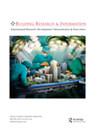Cleanroom air quality: combined effects of ventilation rate and filtration schemes in a laboratory cleanroom
IF 3.7
3区 工程技术
Q1 CONSTRUCTION & BUILDING TECHNOLOGY
引用次数: 3
Abstract
ABSTRACT Ventilation performance and air quality in cleanrooms are affected by several interconnected parameters, and a change in one component can impact the entire system. Furthermore, occupant interactions with the physical environment can influence particle dispersion, disrupt current airflow by introducing new wakes and ultimately decrease ventilation efficacy. As a result, we set up an experimental study to measure the effects of traffic, flowrate and filtration on ventilation performance while a source of contamination was inside the room. Experiments included three types of occupant movements (i.e., NM, WO, WT) and were performed under two different airflow conditions. Three different metrics, namely relative ventilation efficiency ( ), decay rate (R) and exposure (γ), were introduced to statistically compare changes in ventilation performance in response to different experimental setups. Decay rates obtained for 0.3-micron particles decreased by up to 50% in the presence of occupants. Lowering cleanroom flowrate due to additional filtering can reduced ventilation effectiveness by almost 50%. Care should be exercised when changing filter efficiency because it can reduce the rate of air supply. These findings are especially intriguing in the context of cleanroom retrofit, as reducing air exchange rates was an unintended consequence of improving filter efficiency.洁净室空气质量:实验室洁净室通风率和过滤方案的综合影响
摘要洁净室的通风性能和空气质量受到几个相互关联的参数的影响,一个组件的变化可能会影响整个系统。此外,居住者与物理环境的相互作用会影响颗粒的分散,通过引入新的尾流扰乱当前的气流,并最终降低通风效果。因此,我们进行了一项实验研究,以测量当污染源在房间内时,交通、流量和过滤对通风性能的影响。实验包括三种类型的乘员运动(即NM、WO、WT),并在两种不同的气流条件下进行。引入了三种不同的指标,即相对通气效率()、衰减率(R)和暴露量(γ),以统计比较不同实验设置下通气性能的变化。在有居住者的情况下,0.3微米颗粒的衰变率降低了50%。由于额外的过滤而降低洁净室的流量会使通风效率降低近50%。改变过滤器效率时应小心,因为这会降低空气供应速率。这些发现在洁净室改造的背景下尤其有趣,因为降低空气交换率是提高过滤器效率的意外结果。
本文章由计算机程序翻译,如有差异,请以英文原文为准。
求助全文
约1分钟内获得全文
求助全文
来源期刊

Building Research and Information
工程技术-结构与建筑技术
CiteScore
8.60
自引率
7.70%
发文量
43
审稿时长
>12 weeks
期刊介绍:
BUILDING RESEARCH & INFORMATION (BRI) is a leading international refereed journal focussed on buildings and their supporting systems. Unique to BRI is a focus on a holistic, transdisciplinary approach to buildings and the complexity of issues involving the built environment with other systems over the course of their life: planning, briefing, design, construction, occupation and use, property exchange and evaluation, maintenance, alteration and end of life. Published articles provide conceptual and evidence-based approaches which reflect the complexity and linkages between cultural, environmental, economic, social, organisational, quality of life, health, well-being, design and engineering of the built environment.
 求助内容:
求助内容: 应助结果提醒方式:
应助结果提醒方式:


